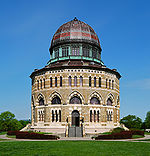Seeley Farmhouse
Greek Revival houses in New York (state)Houses completed in 1850Houses in Schenectady County, New YorkHouses on the National Register of Historic Places in New York (state)National Register of Historic Places in Schenectady County, New York ... and 1 more
Schenectady County, New York Registered Historic Place stubs
Seeley Farmhouse, also known as Little Richard's Tavern, is a historic home located at Glenville in Schenectady County, New York. The L-shaped building consists of two main blocks. The front block took its present form about 1850 and is in an atypical Greek Revival style. It consists of a 2-story central pedimented pavilion with flanking 1+1⁄2-story wings.It was added to the National Register of Historic Places in 1978.
Excerpt from the Wikipedia article Seeley Farmhouse (License: CC BY-SA 3.0, Authors).Seeley Farmhouse
Freemans Bridge Road,
Geographical coordinates (GPS) Address Nearby Places Show on map
Geographical coordinates (GPS)
| Latitude | Longitude |
|---|---|
| N 42.831666666667 ° | E -73.930555555556 ° |
Address
Water's Edge Lighthouse Restaurant
Freemans Bridge Road 2
12302
New York, United States
Open on Google Maps







